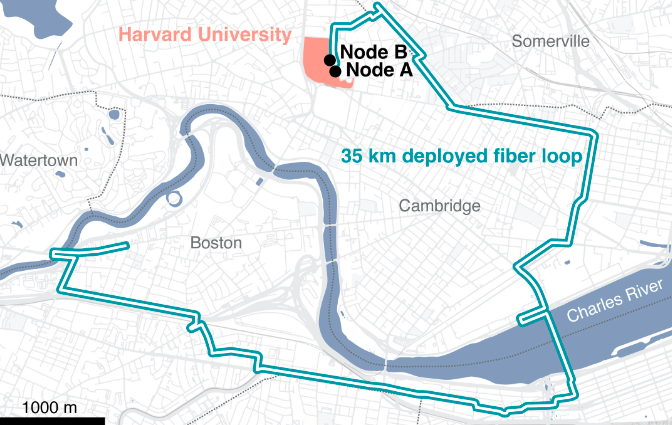This quantum internet holds the potential to dispatch impervious information globally, founded on the principles of quantum mechanics. Its emergence marks a pivotal stride in the evolution of telecommunications. While hurdles persist, recent achievements, such as a groundbreaking endeavor by Harvard University researchers, signify progress.
The Harvard team achieved a remarkable feat by showcasing the elongated transmission between two pivotal nodes utilizing pre-existing fiber optics infrastructure within the urban expanse of Boston. The fiber trajectory spanned a distance of 35 kilometers (equivalent to 22 miles), encircling the city’s periphery. Interestingly, the nodes linking along this route were spatially disjunct, separated by a solitary floor, thus rendering the fiber pathway not the most direct but rather a more intricate route.
Albeit quantum information has traversed greater distances previously, the experiment heralds notable innovations conducive to realizing a functional quantum internet. Notably, these advancements extend beyond the utilization of conventional optical fibers to encompass the node architecture.
Conventional networks employ optical fiber signal repeaters, comprising amalgamated optical receivers, electrical amplifiers, and optical transmitters, pivotal for signal propagation. However, the conventional repeater architecture proves incompatible with quantum internet due to inherent constraints in quantum mechanics.
The crux of the issue lies not in technological inadequacies but rather in the foundational tenets of physics. Quantum information defies replication, owing to its entangled state, which underpins its security. The Harvard system circumvents this challenge by endowing each node with quantum computing capabilities for information storage, processing, and transmission. Despite comprising merely two nodes, this quantum network sets a precedent as the lengthiest quantum network thus far to encompass such functionalities.
Professor Mikhail Lukin, the senior author, underscores the significance of demonstrating entangled quantum network nodes within the bustling urban milieu, deeming it a pivotal stride towards operationalizing interconnectivity among quantum computers.
Each node features a minute quantum computing apparatus fashioned from a sliver of diamond harboring a structural anomaly known as a silicon vacancy center. When subjected to temperatures approaching absolute zero, these silicon vacancies adeptly capture, retain, and entangle informational bits, rendering them ideal for node deployment.
The transfer of entanglement from the first to the second node transpires seamlessly, facilitated by pre-established entanglement of light with the initial node, a phenomenon termed “photon-mediated entanglement,” elucidated by Can Knaut, the primary author and a doctoral candidate in Lukin’s laboratory.
The findings of this groundbreaking study are documented in the esteemed journal Nature.
This article was originally published on iflscience. Read the orignal article.
FAQs
- What is quantum communication? Quantum communication utilizes the principles of quantum mechanics to transmit information securely over long distances.
- How does quantum encryption work? Quantum encryption uses quantum bits or qubits to encode data in a way that is provably secure against eavesdropping.
- What are the main challenges facing quantum networks? Scalability, hardware development, and integration with existing infrastructure are among the key challenges facing quantum networks.
- What are some practical applications of quantum networks? Quantum networks have applications in secure communication, cryptography, and data transmission for various industries.
- What is the significance of testing quantum networks on existing fiber optics? Testing quantum networks on existing fiber optics demonstrates the feasibility of integrating quantum communication with existing infrastructure.
